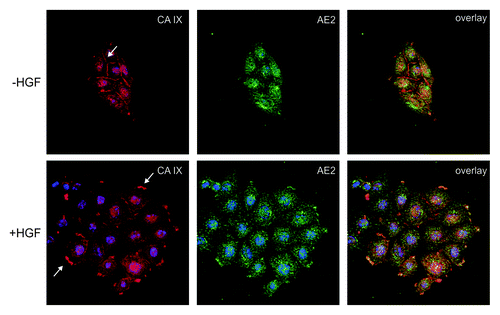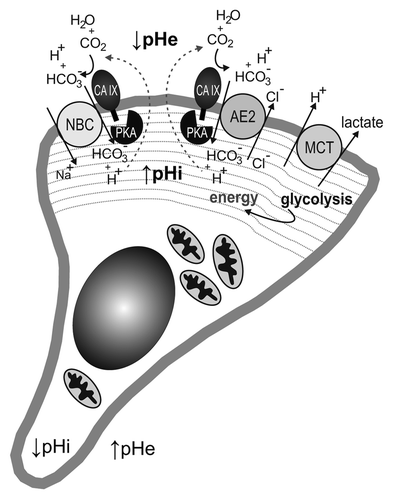Figures & data
Figure 1. Co-localization of CA IX with AE2 in SiHa cervical carcinoma cells. The cells were grown in islands and exposed to hypoxia for 48 h. Then they were stimulated to migration with HGF (+ HGF) or left un-stimulated (− HGF), double-stained for CA IX (red) and AE2 (green) and subjected to confocal microscopic analysis. In absence of HGF, CA IX was present in the plasma membrane regions involved in intercellular connections, whereas the contact-free membranes were devoid of this protein. Punctate cytoplasmic staining represents precursor forms of CA IX as well as AE2. In HGF stimulated cells, both CA IX and AE2 underwent re-localization to the newly formed lamellipodia in accordance with their coordinated functional involvement in pH control at the protruding membranes of the migrating cells.

Figure 2. Schematic illustration of a migrating cell with a lamellipodium in the protruding front. The lamellipodium (indicated by dashed gray lines) contains bicarbonate metabolon(s) composed of bicarbonate transporter (sodium-bicarbonate co-transporter, NBC, and/or anion exchanger, AE2) cooperating with carbonic anhydrase IX (CA IX). CA IX is activated through the phosphorylation of its C-terminal Thr443 mediated by protein kinase A (PKA), which is also confined to and activated in the lamellipodial compartment. Catalytic conversion of pericellular carbon dioxide by CA IX produces bicarbonate ions that are imported by NBC and/or AE2 in order to increase the intracellular pH (pHi) and at the same time generates extracellular protons that acidify extracellular pH (pHe). The lamellipodium is also characterized by the absence of mitochondria and by a glycolytic metabolism, thus generating energy for the cell remodeling favoring migration and producing lactate that is extruded together with protons to the pericellular space by monocarboxylate transporter (MCT). This leads to a reversed pH gradient at the front membrane, with acidosis outside and slightly alkaline pH inside the lamellipodium.
